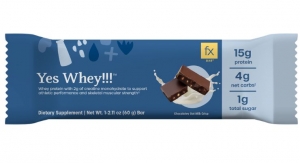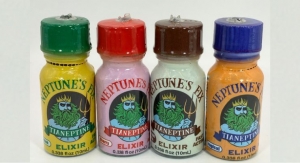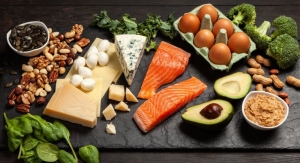Stephen Tindal, Director, Science and Technology, Catalent Pharma Solutions03.01.17
In the last century, life expectancy rose dramatically among the world’s wealthiest populations from around 50, to over 75 years by the turn of the millennium. The improvements in longevity, driven by factors such as improved food supply, nutrition, hygiene and improved access to better medicines, have led to a growing proportion of the population being classified as elderly, and this trend continues to increase.
Euromonitor estimated that the number of adults over the age of 65 will increase by at least two-thirds between now and 2030, topping the one billion mark for the first time. This larger, wealthy population represents a clear and growing market for manufacturers of products designed to promote healthy aging, as on average, a person has eight years toward the end of their life when their health is likely to be poor.
Euromonitor put the global market size for consumer healthcare products at $210 billion in 2015, and this is expected to rise by over 6% by 2020. Within this market, a significant proportion of OTC healthcare products are targeted to aging consumers. In addition to OTC painkillers and antacids that treat specific conditions, dietary supplements such as omega-3 fatty acids, probiotics, glucosamine and other ingredients also help address cardiovascular health, digestion and joint health.
The dietary supplement category is growing steadily, by 4% in 2015, as a result of the recovering economy leading to higher disposable incomes, combined with that growing desire for products to aid healthy aging. OTC products are growing strong, too, partly for these same reasons, but also because of the expanding number of formerly prescription-only products that are being switched to non-prescription status. Many of these are very attractive for the older consumer, and are now readily available either on pharmacy shelves, or after a conversation with the pharmacist.
This represents a huge opportunity for manufacturers of consumer healthcare products. If brand recognition and loyalty among consumers can be created for these newly added OTC products, there is the potential to significantly increase market share, particularly if they can deliver new benefits that meet the needs of aging consumers.
Creating Consumer Advantages
There are many ways one might imagine creating a product that stands out from the competition. It might be offered in a format that is easier to swallow, or perhaps have a more pleasant taste than an alternative. It might have a more rapid onset of action, or simply look more attractive.
One established dosage form that can meet all these requirements is the soft gelatin capsule, or softgel. The process for the mechanized production of large quantities of softgel was invented more than 80 years ago, so softgels are familiar to consumers and already have widespread acceptance in the marketplace. Some products, such as fish oil supplements, are today rarely found in any other format.
Within the softgel shell, the active ingredients are dissolved in polyethylene glycol or a compatible oil, or if they are insoluble then the powdered active ingredient can be suspended in an oil. As precise dosing is more easily achieved in a liquid than dispersed in a solid tablet, they are particularly useful for very low dose actives such as vitamin D supplements.
The shell of a standard softgel comprises gelatin, water and plasticizers such as glycerin and sorbitol. Other ingredients can be added to modify its appearance, such as colors and opacifiers; flavoring agents are also commonly added. The shell provides protection for the contents from the atmosphere, which is important if any of the components within are sensitive to oxygen, moisture, or both. This is key to the ability to produce fish oil products with a long shelf life, as omega-3s are notorious for going rancid through oxidation in the presence of air.
The versatility of the softgel technology allows for many variations to the standard gelatin-based approach. These include the development of vegetarian alternatives such as Catalent’s Vegicaps capsules, made with plant polysaccharides in place of traditional gelatin sourced from bovine, porcine or fish skin. Compliance with vegetarian and non-GMO dietary requirements are not the only advantages of these products, the shell has a higher heat tolerance, and therefore can be processed at more elevated temperatures than are possible with traditional gelatin. This widens the range of compatible ingredients, such as shea butter, which is encapsulated at 60°C and not possible to do with a gelatin capsule.
Evolution in Softgel Technology & How They are Made
It is possible to create smaller dose forms such as Catalent’s OptiGel Mini for OTC products. By using concentrated formulations, it is possible to create products that provide full strength efficacy, but in a softgel approximately 30% smaller than traditional dose forms. This increases the market potential of products to consumers such as the elderly or children who may have issues with swallowing regular sized capsules.
Additionally, instead of forming softgels through a rotary die process, by utilizing a method which produces a droplet, streamline flow, it is possible to create spherical capsules between 1 and 7 mm in diameter. These OptiGel Micro capsules offer an even smaller alternative and flexible dosing options for older consumers who may have difficulty swallowing large pills.
The ability to create products that combine two different actives within one product has real potential to appeal to older consumers, as it could reduce the number of individual doses that have to be taken at one time. The elderly especially tend to be more heavily medicated, so reducing the dose burden can increase the likelihood of compliance. There are several ways in which this might be achieved without mixing the two in the fill. One active might be included within the shell, and the other in the fill. Another possibility, if one of the actives is low dose, is to include that second, low dose, active in a coating applied to the outside of a softgel filled with the other active.
Chewable products are particularly appropriate for nutritional supplements, especially for the age groups and consumers who might have difficulty swallowing standard oral doses. As well as dispersible tablets and jellies, chewable softgels are also available. Catalent’s EasyBurst chewables are designed and produced with a thinner gelatin shell than traditional softgels, so that upon chewing, the shell breaks and the product is then dispersed in the mouth, and the softgel does not need to be swallowed whole. This raises the issue of taste-masking, as it is important to ensure that any product that is designed to be retained within the mouth any longer than momentarily remains palatable throughout. If this can be achieved then appealing products may command a price premium.
Choosing the Right Formulation
For a successful formulation, it is always important to match the format and excipients to the properties of the active ingredients and the desired delivery profile. Softgels are unusual in that they can be tailored to achieve successful delivery of most types of active ingredient. A standard softgel will be sufficient if the active has good bioavailability, unless specific properties such as chewability are desirable. If it has good permeability but is insoluble, a lipid-based delivery system can usually be designed to facilitate delivery. This can be oil-free or all-oil, or anywhere on the spectrum in between; if there is no oil, then lipid or hydrophilic surfactants, or a hydrophilic co-solvent, will need to be added.
The quantity of oil that is present has a bearing on how the softgel will behave once it is taken. An all-oil product will usually need to be swallowed and digested to permit absorption. An alternative strategy is to create a self-emulsifying lipid-based system. These form microemulsions on contact with water, removing the need for digestion. This may seem simple, but can be very important for supplements and OTC products where variability between patients or consumers is common (e.g., Coenzyme Q10 containing supplements for heart health).
Another advantage of softgels, particularly those that are formulated to be self-emulsifying, is that they are often more rapidly absorbed than other dosage formats. Because the active is already solubilized, it is common for a greater proportion of the active to enter the bloodstream, and enter it more quickly, than with a tablet. For OTC products to treat headaches and other forms of pain, the advantages and appeal of faster action are obvious.
Softgels can also be used to improve bioavailability in those actives where it is limited, even if they are insoluble. This can be achieved by milling the active into sub-micron particles, and then using this in suspension within a lipid-based formulation.
Palatability can be further improved by modifying the fill to reduce reflux odor in products such as fish oils and garlic supplements where this might be a problem. An enteric coating can be added to modify delivery location.
Softgel capsules are already familiar to many consumers, and for many who add nutritional supplements to their diet, are well-liked and seen to be advantageous dose forms. For the product manufacturers, this acceptance by consumers increases the market potential of the technology, especially given the technological advances within the science to smaller dose forms, wider range of fill solutions, plant-based ingredients and controlled or modified product release profiles. With these advances, and the versatility of the platform allowing product and brand definition within the marketplace through the use of colors, opacifiers and even inline printing, it is possible to create products that consumers are likely to choose ahead of the competition.
The obvious winners with this are of course the consumers, who have access to better products that give them a better “experience.” This comes by the product being more convenient to take, with better flavors and palatability, and the potential to combine ingredients to reduce the overall daily pill burden. It is important for innovators to understand the needs of aging consumers. Products that increase the likelihood of compliance have an opportunity to stand out in this crowded marketplace.
Headquartered in Somerset, NJ, Catalent is a global provider of advanced delivery technologies and development solutions for drugs, biologics and consumer health products. For more information, visit www.catalent.com.
Euromonitor estimated that the number of adults over the age of 65 will increase by at least two-thirds between now and 2030, topping the one billion mark for the first time. This larger, wealthy population represents a clear and growing market for manufacturers of products designed to promote healthy aging, as on average, a person has eight years toward the end of their life when their health is likely to be poor.
Euromonitor put the global market size for consumer healthcare products at $210 billion in 2015, and this is expected to rise by over 6% by 2020. Within this market, a significant proportion of OTC healthcare products are targeted to aging consumers. In addition to OTC painkillers and antacids that treat specific conditions, dietary supplements such as omega-3 fatty acids, probiotics, glucosamine and other ingredients also help address cardiovascular health, digestion and joint health.
The dietary supplement category is growing steadily, by 4% in 2015, as a result of the recovering economy leading to higher disposable incomes, combined with that growing desire for products to aid healthy aging. OTC products are growing strong, too, partly for these same reasons, but also because of the expanding number of formerly prescription-only products that are being switched to non-prescription status. Many of these are very attractive for the older consumer, and are now readily available either on pharmacy shelves, or after a conversation with the pharmacist.
This represents a huge opportunity for manufacturers of consumer healthcare products. If brand recognition and loyalty among consumers can be created for these newly added OTC products, there is the potential to significantly increase market share, particularly if they can deliver new benefits that meet the needs of aging consumers.
Creating Consumer Advantages
There are many ways one might imagine creating a product that stands out from the competition. It might be offered in a format that is easier to swallow, or perhaps have a more pleasant taste than an alternative. It might have a more rapid onset of action, or simply look more attractive.
One established dosage form that can meet all these requirements is the soft gelatin capsule, or softgel. The process for the mechanized production of large quantities of softgel was invented more than 80 years ago, so softgels are familiar to consumers and already have widespread acceptance in the marketplace. Some products, such as fish oil supplements, are today rarely found in any other format.
Within the softgel shell, the active ingredients are dissolved in polyethylene glycol or a compatible oil, or if they are insoluble then the powdered active ingredient can be suspended in an oil. As precise dosing is more easily achieved in a liquid than dispersed in a solid tablet, they are particularly useful for very low dose actives such as vitamin D supplements.
The shell of a standard softgel comprises gelatin, water and plasticizers such as glycerin and sorbitol. Other ingredients can be added to modify its appearance, such as colors and opacifiers; flavoring agents are also commonly added. The shell provides protection for the contents from the atmosphere, which is important if any of the components within are sensitive to oxygen, moisture, or both. This is key to the ability to produce fish oil products with a long shelf life, as omega-3s are notorious for going rancid through oxidation in the presence of air.
The versatility of the softgel technology allows for many variations to the standard gelatin-based approach. These include the development of vegetarian alternatives such as Catalent’s Vegicaps capsules, made with plant polysaccharides in place of traditional gelatin sourced from bovine, porcine or fish skin. Compliance with vegetarian and non-GMO dietary requirements are not the only advantages of these products, the shell has a higher heat tolerance, and therefore can be processed at more elevated temperatures than are possible with traditional gelatin. This widens the range of compatible ingredients, such as shea butter, which is encapsulated at 60°C and not possible to do with a gelatin capsule.
Evolution in Softgel Technology & How They are Made
It is possible to create smaller dose forms such as Catalent’s OptiGel Mini for OTC products. By using concentrated formulations, it is possible to create products that provide full strength efficacy, but in a softgel approximately 30% smaller than traditional dose forms. This increases the market potential of products to consumers such as the elderly or children who may have issues with swallowing regular sized capsules.
Additionally, instead of forming softgels through a rotary die process, by utilizing a method which produces a droplet, streamline flow, it is possible to create spherical capsules between 1 and 7 mm in diameter. These OptiGel Micro capsules offer an even smaller alternative and flexible dosing options for older consumers who may have difficulty swallowing large pills.
The ability to create products that combine two different actives within one product has real potential to appeal to older consumers, as it could reduce the number of individual doses that have to be taken at one time. The elderly especially tend to be more heavily medicated, so reducing the dose burden can increase the likelihood of compliance. There are several ways in which this might be achieved without mixing the two in the fill. One active might be included within the shell, and the other in the fill. Another possibility, if one of the actives is low dose, is to include that second, low dose, active in a coating applied to the outside of a softgel filled with the other active.
Chewable products are particularly appropriate for nutritional supplements, especially for the age groups and consumers who might have difficulty swallowing standard oral doses. As well as dispersible tablets and jellies, chewable softgels are also available. Catalent’s EasyBurst chewables are designed and produced with a thinner gelatin shell than traditional softgels, so that upon chewing, the shell breaks and the product is then dispersed in the mouth, and the softgel does not need to be swallowed whole. This raises the issue of taste-masking, as it is important to ensure that any product that is designed to be retained within the mouth any longer than momentarily remains palatable throughout. If this can be achieved then appealing products may command a price premium.
Choosing the Right Formulation
For a successful formulation, it is always important to match the format and excipients to the properties of the active ingredients and the desired delivery profile. Softgels are unusual in that they can be tailored to achieve successful delivery of most types of active ingredient. A standard softgel will be sufficient if the active has good bioavailability, unless specific properties such as chewability are desirable. If it has good permeability but is insoluble, a lipid-based delivery system can usually be designed to facilitate delivery. This can be oil-free or all-oil, or anywhere on the spectrum in between; if there is no oil, then lipid or hydrophilic surfactants, or a hydrophilic co-solvent, will need to be added.
The quantity of oil that is present has a bearing on how the softgel will behave once it is taken. An all-oil product will usually need to be swallowed and digested to permit absorption. An alternative strategy is to create a self-emulsifying lipid-based system. These form microemulsions on contact with water, removing the need for digestion. This may seem simple, but can be very important for supplements and OTC products where variability between patients or consumers is common (e.g., Coenzyme Q10 containing supplements for heart health).
Another advantage of softgels, particularly those that are formulated to be self-emulsifying, is that they are often more rapidly absorbed than other dosage formats. Because the active is already solubilized, it is common for a greater proportion of the active to enter the bloodstream, and enter it more quickly, than with a tablet. For OTC products to treat headaches and other forms of pain, the advantages and appeal of faster action are obvious.
Softgels can also be used to improve bioavailability in those actives where it is limited, even if they are insoluble. This can be achieved by milling the active into sub-micron particles, and then using this in suspension within a lipid-based formulation.
Palatability can be further improved by modifying the fill to reduce reflux odor in products such as fish oils and garlic supplements where this might be a problem. An enteric coating can be added to modify delivery location.
Softgel capsules are already familiar to many consumers, and for many who add nutritional supplements to their diet, are well-liked and seen to be advantageous dose forms. For the product manufacturers, this acceptance by consumers increases the market potential of the technology, especially given the technological advances within the science to smaller dose forms, wider range of fill solutions, plant-based ingredients and controlled or modified product release profiles. With these advances, and the versatility of the platform allowing product and brand definition within the marketplace through the use of colors, opacifiers and even inline printing, it is possible to create products that consumers are likely to choose ahead of the competition.
The obvious winners with this are of course the consumers, who have access to better products that give them a better “experience.” This comes by the product being more convenient to take, with better flavors and palatability, and the potential to combine ingredients to reduce the overall daily pill burden. It is important for innovators to understand the needs of aging consumers. Products that increase the likelihood of compliance have an opportunity to stand out in this crowded marketplace.
Headquartered in Somerset, NJ, Catalent is a global provider of advanced delivery technologies and development solutions for drugs, biologics and consumer health products. For more information, visit www.catalent.com.




























